#afrikan centered
Text


Peace
There is No Official statement nor stance from Allah School in Mecca/5% Nation of Gods ands Earths Headquaters gives No Official statement for the War or Conflict!
Condolences to people that lost their lives regardless to whom or what!
You need to ask individual Gods and Earths for their individual opinions on the subject.
Please consult history before speaking on the subject matter
Below are resources that are not mainstream sources. Please investigate further. Question all things, take nothing on face value!
youtube
https://mondoweiss.net/
youtube
#nation of gods and earths#supreme mathematics#five percent nation#allah school in mecca#hip hop#5% nation of gods and earths#black women#father allah#black people#black men#Youtube#palestine#Israel#israel palestine conflict#Black men#afro latina#latinos#hip hop rappers#african#afrikan centered#pan african#black nationlism#cultural nationalism#God#Allah#Yahweh
15 notes
·
View notes
Text
The world-renowned SCHOMBURG Center for Research in Black Culture will live stream the Memorial Tribute for Sekou Odinga on Saturday, June 8, 2024; 6-9 PM EST; 3-6 PM PST
www.youtube.com/live/UVJiksZce3w
View On WordPress
#African/Black experience#Afrikan#Artists#BLA#Black Panther Party#BPP#culture#freedom#liberation#Memorial Tribute#New York#Political Prisoners#revolutionary#revolutionary leaders#SCHOMBURG Center for Research & Black Culture#Sekou Odinga
0 notes
Text
Some tangible Black queer history for you!
In case you needed any more proof that we've always been here - this amazing collection is courtesy of the Stonewall National Musuem and Archive!
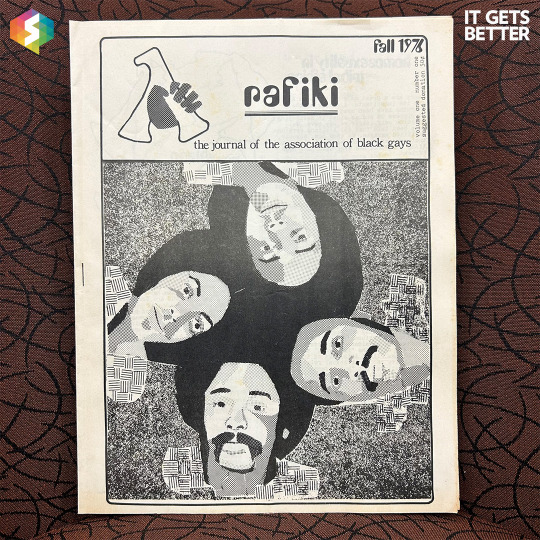
Rafiki: The Journal of the Association of Black Gays, Vol. 1 #1 (Fall 1976)
"Rafiki was a quarterly publication from the Association of Black Gays (ABG), a Los Angeles, California gay activist group that organized through education, political engagement, and grassroots activism to
improve the conditions for Los Angeles’s Black gays and lesbians.
According to the journal, the title Rafiki was chosen because it means “friend” in Swahili and “that’s what [ABG] hope to be for you.” This first issue includes an article on the history of ABG and the fact that Black gays and lesbians have been largely excluded from the political, social, and economic advances of the gay community.
Included in this issue are articles such as “Homosexuality in Tribal Africa” and “Disco Discontent” (an open letter to the owner of Studio One, Scott Forbes), as well as poetry by Steven Corbin and Frances Andrews, and book reviews. It even contains an ad for the famous Catch One Club owned by Jewel Williams, which is still
operating today!"

I Am Your Sister: Black Women Organizing Across Sexualities by Audre Lorde (Kitchen Table: Women of Color Press, 1985; from the Freedom Organizing Series)
You can read this one here!
"This small twelve-page publication derives from a speech Audre Lorde gave at the Women’s Center of Medgar Evers College in New York City regarding the exclusion of Lesbians in the feminist movement and how Lorde’s identity as both a Black woman and lesbian are inextricably linked.
Primarily, heterosexism and homophobia are major issues Lorde states are “two grave barriers to organizing among Black women.” Lorde ends the essay with the statement: “I am a Black Lesbian, and I am your sister.”
Her emphasis on the duality of this identity stems from a 1960s poster that said “He’s not black, he’s my brother!,” which Lorde states infuriated her because “it implied that the two were mutually
exclusive.”
Kitchen Table: Women of Color Press was founded by Barbara Smith—another Black Lesbian feminist—and Audre Lorde in 1980 to create a publishing apparatus for women of color who at the time did not have control over how they were published except through the white-dominated outlets."

Flawless! The Life & Times of T.B.D.J. AKA Tiffani Inc. AKA Mrs. … (Manuscript) by Tiffany Bowerman (July 2007, A&E Publishers)
This autobiographical manuscript traces the life of Tiffany Bowerman aka Tiffany B.D. Johnson (b. 1959), who states that she “was the first African-American Transsexual to have state issued birth certificate reissued [1990]… was the first to legally marry three different active duty military men… [and] first… to found their own Christian Denomination… The Agape-Ecumenical Christian Denomination.”
Further, she states “I have tried to put together something striking and original[,] a journey from childhood to self aware adult. A life that was and is with all regrets included.”
This manuscript is a preliminary copy of a rough draft, and contains various memoirs, photographs, legal documents, and ephemera.
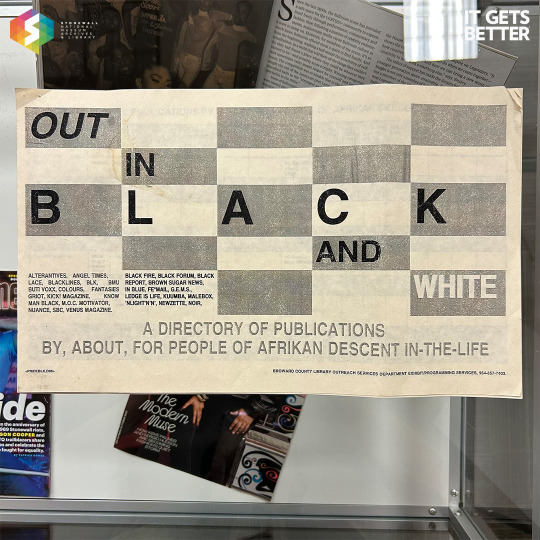
Out in Black and White: A Directory of Publications By, About, For People of Afrikan Descent In-The-Life by the Broward County Library Outreach Services Department Exhibit/Programming Services with direction by Eric Jon Rawlins (January, 1996)
Out in Black and White is a directory of various serial publications (magazines, newsletters, journals, etc.) throughout the United States that are focused on the Black LGBTQ experience. According to the directory, “[t]his project was inspired by the atmosphere of strength, oneness and productivity created by the Million Man March [on October 16,] 1995.”
The Million Man March was a political demonstration that took place at the National Mall in Washington, D.C. with the purpose of encouraging involvement in the improvement of the conditions of African Americans. Eric Jon Rawlins was a Broward County, Florida librarian who at one time was also the second vice president of the NAACP Fort Lauderdale branch in the late 1980s.
Currently, the Eric Jon Rawlins Collection consisting of personal and professional papers, as well as his 6,000 vinyl record album collection, are housed at the African American Research Library and Cultural Center Special Collections in Broward County, FL.
#it gets better#black history month#bhm#black trans lives matter#lgbtqia#queer history#lgbtq history#black history#queer archive#queer lit#studyblr
108 notes
·
View notes
Text
The Difference between The Black Agenda & The Reparations Movement
Reparations Commissions are popping up across the Country, but none of them come close to addressing the true spirit of Reparations. There are several reasons for this:
Neither Democrats nor Republicans in Congress have a real interest in discussing Reparations; let alone dispensing anything tangible.
Minorities involved in these Reparations Projects have either tried to include their demographic into the discussion, or they have been against it.
Infighting amongst members of the ADOS, FBA, Freemen, & Indigenous Community have weakened the overall message of Reparations. The Masses don't realize that they are All THE SAME LINEAGE GROUP. This division weakens Our collective argument, but has allowed some to eat well over the past few Yrs.
Organizations like The NAACP, The Urban League, The National Action Network, NCOBRA, NAARC, & other like minded Groups have promoted a Trans Atlantic Reparations Agenda that ignores CARICOM. In effect, it 'Centers' Black Immigrants (including Afro Latinos) in the Black American Experience. Most arrived @ least 10Yrs after Jim Crow ended- how do they qualify for American Reparations?
The recent kerfuffle over San Francisco NAACP President Rev. Amos Brown's rejection of that City's Reparations Proposal spotlights the problem w/ letting Our (so called) 'Established Leaders' drive the Reparations Bus. They drove the Bus into Our current situation, why should We expect anything different from them? Many of these individuals chose Corporate Donations over Black Community Development. They arent 'Leaders', they're Corporate Lobbyists. These are the Same People that let HR- 40 rot on the 'Social Action vine' for over 30Yrs; If they REALLY wanted Reparations...
Another issue, are the individuals & Organizations narrating 'The Black Agenda' into the Reparations Argument. They are separate & distinct. The White Noise of their rhetoric has confused The Masses, which weakens the magnitude of Our Fight. For the sake of clarity, I want to point out the difference between The Black Agenda & The Reparations Movement.
The Black Agenda, is an All inclusive Program for Black & Afrikan Americans, regardless of their Country of Origin. This includes Africans, Caribbeans, Afro Latinos, & Afro Asians. All of Us share in the current experience of being Black in America. It is an experience that is unique to Us, & is also what unites Us.
The Black Agenda is about Equity. America loves to promote 'Equality', but equal measure doesn't guarantee that Everyone will somehow end up on equal ground. We have been collectively marginalized in America, so it's only fair that they level the playing field. 'Rising Tide' Programs, like those offered by The Democratic Party are on the right track, but none take into account the fact that Black America needs an extra scoop of whatever they propose.
The Black Agenda deals w/ the issues of Community Development: Residential & Commercial/ Business Property Ownership, Job Development & Employment Opportunities, Health Care & Mental Health Solutions, School Reform, After School Programs, Youth Empowerment, Visual & Performing Arts Programs, Daycare & Pre- K Programs, along w/ the necessary Community Boards needed to present these & other Community related issues to Local & State Agencies. The goal, is to improve the overall Quality of Life in Black Communities- up to the level of Every Other Community.
The Reparations Movement, is a specific call for American Society to pay their long overdue debt to American Descendants of Chattel Slavery. This Movement is about Indemnification. While Black America collectively deserves legislation, American Descendants Of Slavery deserve much more. The problem w/ EVERY Reparations Program offered so far, is they All ignore the fact that Reparations is a debt owed. They All read like Politicians are giving Blackfolk a hand out. These Programs also fall short on what is really owed.
A lot of numbers have been thrown around over the years, but I have consistently said that Final Reparations numbers will depend on WHO is held liable. If the U.S. Government alone is held liable, Reparations will probably be in the $18 Trillion- $22 Trillion range. If Corporations & Individual families are included, that number could reach $64 Trillion. That should give a clue to the extent of Exploitation, Terrorism & Oppression that Black America endured over the last 246Yrs- 400Yrs. American History is a chronicle of Anti- Black sentiment. Reparations Naysayers point out the impossibility of dispensing Trillions of Dollars, but a Multigenerational Reparations Program is an easy solution.
The Republican Party's outright refusal of, & The Democratic Party's attempt to graft Feminist & LGBTQ... rhetoric to Critical Race Theory (CRT), are attempts by both Parties to keep Mainstream America away from Our Nation's cruel & bloody past. They obviously fear divulging this history, because it will quell the Argument 'Against', as it strengthens the National Argument 'For' Reparations. The Immigrant Argument of 'I wasnt Here' becomes embarrassing, when We consider 2 facts:
It was Black American Labor that built America up & made it attractive (i.e. The Land of Milk & Honey) to Europeans, Asians, Latinos, Caribbeans, & Afrikans looking to start a New Life.
Black America is responsible for motivating ALL of the Immigration Initatives over the last 150Yrs; especially those since 1965.
It's only fitting for Immigrants living their American Dream (at another's expense) to pay tribute to the people who made that dream possible. I like the analogy of 'Inheriting an Old House'. The New Occupant didn't cause the wear & tear on the house, but that doesn't change the fact that they will have to invest the Time, Work, & Money needed to restore & maintain it. THAT, is the price of Occupancy.
Another thing to consider, is the fact that most Black Americans are descendants of Indigenous Americans or American Indians (Coppertoned Aborigines); not to be confused w/ 'Native Americans', who migrated from Siberia. Less than 10% of Transatlantic Slaves landed in North America. Our Ancestors were Prisoners Of War, that were forced into Indentured Servitude, & later Chattel Slavery on their Own Land. Census Records reveal the effort to hide Our lineage.
Starting w/ the 1790 Census, Indigenous indentured servants were reclassified as Negro & Colored. By the 1900 Census, Indigenous People were being punished for identifying as 'Indian'. They were forced to identify as Colored or Negro. By the 1970 Census, We were designated 'Black'; & on the 1990 Census, We were labeled 'Afrikan American'... Out Of Afrika Theory, while genealogically true, is not only Culturally false; it now appears to be a ploy to get Us off of Our Land. We're looking to Afrika, while the Blood & Bones of Our Ancestors fertilize This Land. Our success in agriculture isn't an accident- We were Here for millennia!... I guess that adds an extra wrinkle to the Reparations Discussion.
It's Time for Us to link the moving parts of Our Lineage into Black Voltron, so We can get on w/ The Work. -Just Saying
#ADOS#CutTheCheck#NoPolicyNoPeace#AgeOfProphecy#BootlickMarginCall#Indigenous#B1#DoctrineOfDiscovery#RacialIntegrityAct
180 notes
·
View notes
Text


Please note that who gets to be "white" is contextual to the center of ethnic power in each region.
Dark-skinned people of Asian, African and Indigenous descent will never be white in any part of the world and will always be vulnerable to white skinned people of European descent. (Excepting the times Japanese and some East Asian peoples with an adequate lack of melanin have been granted conditional whiteness.)
However, Slavs, white Jews, white Latinos, white Roma (white skinned and associated with European origins) are fully white in places where they hold ethnosupremacy and achieve/are granted conditional whiteness of varying levels and privileges in the US, Canada, South Africa and other white settler colonies, and some parts of Europe (Jewish South African settlers had no idea what side of the apartheid fence they would fall until the white Afrikaners made clear they were accepted).
Whiteness in the Western world is also entirely in the purview of the imperial core's narrative. In the Western lens, Eastern Europeans eternally hover between the fact of being white-skinned Europeans and being Orientalised due to their histories as colonies of Russia and Ottoman empire and their shared heritage with Asia Minor. Even the narratives of the Holocaust erase the genocide of Soviet Jewry. (That's right, in Soviet Russia the Holocaust had nothing to do with Jews, which is why Putin keeps accusing Zelensky of being a Nazi). The US and Western Europe's manufacturing of consent for NATO's military alliance with Ukraine at the outbreak of its war with Russia involved efforts to elevate them to full whiteness that were routinely hilarious because demystifying and de-exoticising them (is that a word?) revealed the extent to which they had been Othered, paternalised and exotified (lots of "omg they're humans just like us even though they live in a shitty second world country" stories especially from the UK, ntm journalists parachuting in and seemingly being surprised they had McDonald's and internet access. You could not make this stuff up). You can contrast this directly with how much of a shit they don't give about Armenians because they're Russian allies, even though Armenians are literally white in the US. It's why I have to roll my eyes at the "they care about Ukrainians because they're white" discourse. That's entirely backwards— Ukrainians are white because NATO is invested in them. Otherwise they'd just be another former Soviet Republic up to their usual "savage shenanigans" like the rest of the Eastern Bloc.
You'd think you couldn't pull this same trick with non-Europeans, except that Apartheid South Africa deemed Japanese "honorary whites" (much like Nazi Germany proclaimed them honorary Aryans), and then, hilariously, the rest of the East Asians because they were so pissed off about it. White Australia otoh kept them stubbornly out.
Otoh, Islam is fully and irrevocably racialized (associated with the Middle East even though like...nevermind), which is why Bosniaks and Turks will never be given even conditional whiteness, European or not.
Whatever the geo-political hemisphere, under the global influence of white supremacy, the capacity for the casual public to empathize with a person recedes with the rise of melanin in their appearance. This is why abolitionists used white passing Black Americans to drum up support for their cause among Europeans, why more people will always empathize with white Eastern Europeans, why anti-blackness is its own creature and Black people are so universally dehumanized that even people that care about atrocities in the Middle East pay scant attention to the horrors in Africa where the West and Israel are equally implicated. In the landscapes of our imaginations, the Western cultural hegemony has created the image of dark bodies into a faceless, uncontainable, seething hoarde born to suffer and die; lives stripped bare of names, personalities, agency, intelligence, homelands and dreams.
(Please note this blog is anti-genocide no matter the colour of their skin, by which I mean that what's happening in Ukraine is also one, and no amount of Zionists with their flag in their bios makes it any more acceptable for them to be colonized and slaughtered than it is for any of the several Black and brown people being subjected to the same right now. Human rights are not predicated on good behaviour, or else we'd all be dead.)
#racism#anti blackness#white supremacy#congo genocide#sudan genocide#palestinian genocide#colonization#imperialism#holocaust#armenian genocide#apartheid#war propaganda#eastern europe#knee of huss#free palestine
39 notes
·
View notes
Video
youtube
sbA kmtyw - "Towards Pan-Afrikan Economics" Trailer
sbA kmtyw - "Towards Pan-Afrikan Economics" with Ambakisye Dukuzumurenyi, Ph.D. will be a weekly one-hour podcast | video that discusses and analyzes pertinent economic news of continental Afrika and the Afrikan Diaspora from a Pan-Afrikan perspective as seen through the lens of Maat in the spirit of Martin Delany, Edward Wilmot Blyden, Henry Sylvester Williams, Marcus Garvey, W. E. B. Dubois, Kwame Nkrumah, Ahmed Sekou Toure, Patrice Lumumba, Julius Nyerere, Malcolm X, Frantz Fanon, Walter Rodney, Amilcar Cabral, Thomas Sankara and Cheikh Anta Diop.
Topics discussed will include but will not be limited to national economic self-reliance, wages, employment and unemployment, entrepreneurship, debt, interest rates, balance of payment, prices, profit, foreign exchange, credit, economic growth, sustainable agriculture, land tenure, land reform, neoliberal economics, social democracy, paths to economic development, corruption, illicit financial flows and alternative economics.
On the show we will take complex economic issues drawn from the mainstream and independent news outlets of the countries of Africa, Europe, Asia and the Americas and through cultural, historical and political contextualization make them comprehensible to the audience regardless of their economic background, empowering the listener to analyze their personal economic situation in relation to the national and international political economy.
Special shows will also be designed around the particular economic questions and concerns of the listeners. Our specialty is in utilizing a multidisciplinary inquiry based Pan-African analytical perspective drawing concepts, ideas and theories from the disciplines of Africana Studies, Cultural Anthropology, Political Anthropology, History, Psychology, Sociology, Philosophy, Geography, Linguistics, Political Science, and Economics. The use of this methodology serves to broaden the discussion and analysis and center it within the African subjective historical experience.
6 notes
·
View notes
Text
Anarchist Book Club Presents a reading for March:
Anarkata - A Statement
Afrofuturist Abolitionists of the Americas
Table of Contents:
What Is Anarkata?
Anarkata Tradition
Anarkata Politics
Anarkata Praxis
To What End? The End of the World?
Full text:
What Is Anarkata?
“Anarkata” emerges as a response to the political alienation that has been experienced by Black anarcho adjacent leftists who reject both the whiteness of traditional anarchism and the authoritarianism of some forms of Black nationalism.
21st century “Black Anarchism” as a concept has recently gained more popularity as the works of Lucy Parsons, Lorenzo Kom’boa Ervin, and Kuwasi Balagoon, have become more widely disseminated on the internet (and especially with the publication of the ‘Black Anarchism Reader’). This increased attention and visibility has provided a degree of validation to those of us who are Black radicals that share a common belief in the need for decolonization and self-determination for Afrika and the Diaspora, but who reject an uncritical investment in hierarchy, centralization, and the State as the ways to achieve international Black liberation.
We find Black Anarchism as a political tendency particularly attractive because of its flexibility— how it draws from a number of revolutionary frameworks—Black Marxism, Maoism, Pan Afrikanism, Black feminism, Queer liberation—which makes it not just opposed to the Western and capitalist forces oppressing Black people, but also the transmisic, heterosexist, misogynistic, disablist, and human-centered forces working against us as well. Most of us in “anarchic” Black radical movements, however, find ourselves overlooked, and our politics get confused and dismissed as synonymous with classical, European Anarchism—which is itself often misunderstood by the non-anarchic world as largely an aesthetic and utopian movement, perhaps where people in bandannas smash windows or advocate an individualist liberty, a naive pacifism, or simply uncoordinated destruction and “chaos.” It is within this milieu—of the increased popularity and relevance of anarchism to Black revolution, and the confusing or elusive nature of this relevance in the public consciousness due to anarchist mythology—that some of us decided we should develop our own name, to help demonstrate that we locate our anarchic radicalism in our own history as Afrikan/Black people.
The struggle for Black self-determination has often articulated itself through self-naming, whether naming independent parties or religious institutions or choosing non-Anglo/non-European names. Inspired by that tradition of self-naming, it was suggested we could use the term ‘Anarkata,’ to describe ourselves for ourselves within the revolutionary canon. Short for ‘anarchic akata,’ the term is to be a reclamation of the Yoruba word for ‘housecat’ or ‘wild animal’ (we thank Black Youth Project for getting us thinking about this) that has been used to describe Afrikans displaced in Amerikkka. Reclaiming a term that has been on some accounts regarded as a slur and on other accounts is said to be a way to conflate all Black/Afrikan folk with the Black Panther Party was important here. Anarkata means for us that first and foremost the prefix “anarch-“ (meaning ‘without unjust hierarchy’ or ‘without rulers’) would be grounded in the political struggle of ‘Blackness’ as a Pan-Afrikan (and Afrikan Diasporic) set of experiences and revolutionary histories (anarch-akata) and not just in some universalized, unspecified vision about absence of rule (anarch-ist). We would thus be defining domination, subjugation, exploitation and resistance to them in light of Black/Afrikan thought and struggle.
In this way, to be Anarkata is akin to something Ashanti Alston once said, where our Blackness is “…not so much as an ethnic category but… an oppositional force or touchstone for looking at situations differently. Black culture has always been oppositional and is all about finding ways to creatively resist oppression. So, when I speak of a Black anarchism, it is not so tied to the color of my skin but who I am as a person, as someone who can resist, who can see differently when I am stuck, and thus live differently.” Anarkata politics seek to consolidate that flexible culture of Black oppositionalism into a consciously revolutionary, ethical and logical form—especially in response to 21st century problems facing Black/Afrikan people globally such as climate change, environmental racism and disablement, neocolonialism, neofascism, Zionism, settler colonialism, militarized policing, mass incarceration, etc. It is this process of synthesis, a synthesis of Black radical oppositionalities along the lines of a Black nonhierarchical critique (Anarkata synthesis), that is characteristic of the Anarkata approach to Black liberation.
The following document is not to be a founding document for one particular organization but is intended to be a jumping off point for anarchic Black radicals to cohere our diverse thoughts together. The authors have not written this to speak for all things in anarchic Black revolution, but we write this as an invitation to us all to put our heads and minds together. We hope that from this document a set of conversations and relationships can spring by which Anarkatas can then more effectively propagandize and produce a wave of literature that reflects even more of our perspectives. We envision that what’s proffered here get taken up, dissected, rewritten, expanded upon, and challenged beyond here—that this be a living document. We hope that it is used to better inform and enrich the local Black anarchist work already taking place. Zines, videos, memes, lexicons, podcasts, articles— we hope to see all of this and more generated around this document so that the growing energy for and interest in anarchic Black radical politics can be intensified and pushed further. Our hope is that in coming together as Anarkatas we can then work more cohesively to make our traditions, politics, praxes, and freedom visions accessible to everyone.
44 notes
·
View notes
Text

K&S Apparel Uplifting Black lives one Community at a time🖤🖤. To order your "AFRIKAN CENTERED"Tee Shirt and Hat contact @goddess_amenset 404-434-7963 https://kandsapparel.square.site/ ❤️🖤💚 ✊🏿 #sungoddessscents #1stopnaturalshop #ShellyAmenset #webuyblack #internationaldiscount #supportblackbusiness #kandsapparel #forusbyus #shellyamenset #BuyBlack #buyblackowned
21 notes
·
View notes
Text
The Woman King - Combatting the Masculinization of Black Women
I was a little scared to watch The Woman King. I saw from the trailers that the movie contained a bunch of badass, Black women, but I wasn't clear on the plot. The ambiguity of the film's story made me worried for what exactly the movie was trying to accomplish in its portrayal of these women. It wasn't until I'd read up on the women who created the film that I became more excited about seeing the movie. Fortunately, Gina Prince-Blythewood, Maria Bello, and Dana Stevens flooded the movie with opportunities to view womanhood in various perspectives, defining Black femininity through an ironically historical and contemporary lens.

Set in nineteenth-century Africa, the film depicts the typical local life found in history textbooks. In a general sense, most communities were patriarchal and expected piety from women. Additionally, a woman's primary role surrounded her family or tribe as a daughter, mother, or wife, etc. However, during this time period, the Dahomey Kingdom had an additional status for women as warriors, who were revered even more than their male soldier counterparts. It is this culture that the film focuses on and embellishes.
In today's context of modern feminism, the film was evidently intended to primarily show female empowerment. I believe the writers did a wonderful job in showcasing this through story. But the layers of the film can be savored in its representation of African, Black women. This was due to great directing.

Overall, I don't think this film was especially good in that it took artistic liberties, fine-tuned dialogue, or had amazing camera work. Additionally, it was a story we've seen in other forms before, and in my opinion, it failed to add a unique twist on the tale. Despite this, the film was impactful (though I'm a bit biased as a target audience member). There are several scenes that are hard to forget due to their level of intimacy and relevance to modern Black women. For example, one moment that lingers in my mind is when a mentor braids a mentee's hair. For me, that was a perfect example of Black femininity. It showcased their sisterly bond and drew upon generations of braiding in the Afrikan diaspora. It also displayed fortitude, as it was a warrior's hairstyle in this culture. This aspect made me recall warriors of the Southern United States who wore map-like braids and risked their lives to help others. There was much to unpack in that scene. Regardless of the film's execution, I think it accomplished it's goal in terms of representation and positive messaging.

The Woman King was an especially interesting film because it purposefully blurred the lines between masculinity and femininity in an appeal to progressive ideology. Additionally, it centered on brown-skinned and darker skinned women, who have consistently been considered less feminine/desirable than their lighter counterparts due to a Eurocentric standard of beauty. Seeing Viola Davis's bulging muscles and contortion of her face into a war cry is not something traditionally viewed as beautiful, and it may have even fed into some stereotypes surrounding the abrasiveness of Black women. Even so, the feminist motif of the film highlights the fact that women have many facets. As any dynamic character, Viola Davis performs in moments of vulnerability and delves into feminine energy in more usual ways later on. Her beauty is then displayed in her multidimensional character rather than relying solely on either her masculine or feminine behaviors.
All in all, the film was a pleasant watch. I appreciated it more for its purpose than its quality.
Additional comments:
Personally, I could have done without the rushed, lightskin subplot. I get, that it was used to show another key definition of femininity (I hope so anyways). Manz was giving body though.

#woman#king#movie#film#commentary#Black#African#viola#davis#viola davis#race#race and ethnicity#masculinization#women#empowerment#feminism#beauty#standards#woman king#historical#true story
52 notes
·
View notes
Text
THE LAST STAND OF THE GUARDS

The Gulf War’s Ground Campaign and Iraqi Resistance
Good day everybody! Since I loudly declared I would be leaving Twitter until the Afrikaner rodent was dead or missing, I felt I should post this pet-project of mine here instead of on Twitter as a thread.
The Gulf War, at least in its political aspects, was a modern iteration of the Battle of Waterloo, as it represented the decisive military triumph of reaction over progress and development. It was, as Victor Hugo once described Waterloo, “intentionally a counter-revolutionary victory”. It was Iraq against the status-quo. It was the revolutionary Arabism of Baghdad against the triumphant imperialism of Washington D.C, the reactionary backwardness of Riyadh, the comprador-ship and treacherous realpolitik of Cairo and Damascus. The final extinction of that vast people which had been in eruption for thirty-five years, since 1956–such was the dream.
However, that is not what I will be talking about today. See, as much as I would like to delve into the political & historical consequences of this great war, I wish to cover its military details, unlike what Hugo did with Waterloo. Today, I shall be focusing of the Coalition’s ground offensive and the Iraqis’ doomed attempt at resistance. So let’s set the scene.
Bombs over Baghdad and Gorbachev’s Deal
A month has passed since the Coalition started its massive air campaign over the skies of Iraq. A vast armada of close to 2.800 jets and hundreds of cruise missiles hit Iraq’s industrial centers, civilian infrastructure, energy production facilities, even research reactors, with the goal of quite simply returning Iraq, until then the Middle East’s sole modern economy, back into the stone age. More bombs were dropped on Iraq in a month than were dropped on Berlin, Germany’s capital, throughout all of WW2. The Coalition had more or less proven its point, and Iraq wanted out.
An agreement was reached with the Soviet Union, with the hopes that this would present a fait accompli to the Coalition and have them cease the bombings (and hopefully even end the sanctions). According to this agreement, Iraqi ground forces would immediately begin pulling out their units from the “Kuwaiti Theatre of Operations”, with the last units leaving in around a few weeks. In fact, a shadow retreat was already being allowed to happen, with individual divisions ‘melting away’ and reconstituting themselves back in Baghdad. With Tariq Aziz (Iraq’s Deputy PM & Foreign Minister) announcing Gorbachev’s deal and the pullout of all Iraqi forces from the KTO on the radio on the 22nd of February, this shadow retreat suddenly turned into a large and chaotic movement of units still under air attacks, with large traffic queues and more-or-less total abandonment of all Iraqi defensive works which had been prepared in the south of Iraq as well as inside Kuwait (like the well-known “Saddam line”).

As Iraqi troops were hastily withdrawing from their prepared defensive positions and clogging up the vast road networks of Iraq and Kuwait with huge lines of trucks, heavy vehicle transporters, tanks and other military equipment, the Coalition knew it had to act fast. The conclusion of the Gulf Crisis through Soviet mediation and without a crushing defeat of the mass of the Iraqi military was considered an unacceptable result, and thus plans were quickly drawn up to lunge forward at the retreating enemy columns and shatter the mass of the Iraqi military as it was attempting a cumbersome and chaotic march back towards Baghdad, Karbala, Najaf and Basra.
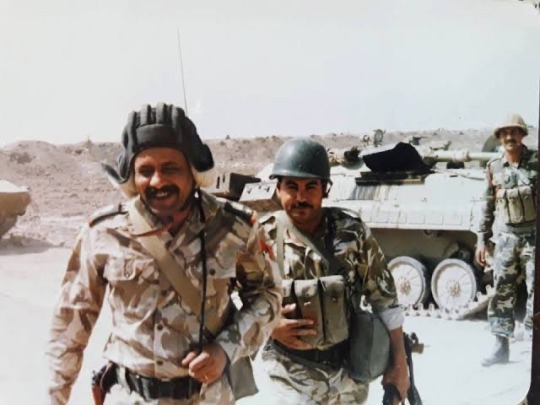
The first Coalition attacks struck (and quickly scattered) vastly outnumbered and confused stragglers from infantry divisions which had been attempting to withdraw from their prepared defensive fortifications. After quickly dealing with these minor centers of resistance, the Coalition units started a large-scale ground offensive relying on shock and speed to either cut off the retreat of Iraqi units on the road or to hit them from the behind and shatter them. Iraq’s military leadership, after shaking off the violent shock of the ground attack (and in their eyes, from the shock of Gorbachev’s betrayal), made the hard and rational, yet arguably callous, choice of ordering their armored-mechanized Republican Guard formations to immediately turn 180 degrees and lunge forward towards the Coalition offensive to either meet them in hastily and rather shoddily improvised defensive positions or to counter attack them with the purpose of delaying their general advance, so the rest of the 50 division strong Iraqi military could withdraw back to Iraq relatively unscathed. With great difficulty, these ‘elite’ formations were able to extract themselves from the large traffic jam which had almost entirely paralyzed the movement of panic-stricken Iraqi units and prepare themselves for the coming battle. This would be their last stand, for they were the modern iteration of Napoleon’s Old Guard, who had been cut down by British musket fire yet fought until destruction, to the bitter end.

Although the Republican Guard had been the preferred target of continuous Coalition air attacks from the outbreak of the war, they had not suffered serious losses due to their safety precautions and effective camouflage procedures. In an interview, a Republican Guard commander claimed that despite attacks from the most advanced planes at the Coalition’s disposal, his forces had suffered relatively few losses. In fact, attacks by A-10 aircraft would have to be called off for the rest of the campaign after suffering significant losses due to RG operated Strela-10 SAM systems.
When the ground offensive got underway on the 24th of February, the Coalition forces stepped up their bombing campaign on the Republican Guard, using large numbers of aircraft and combat helicopters that attacked them constantly. To make sure his units could set up mutually supporting defensive lines in the chaos of the 180 degrees turn and expected attacks by the Coalition’s tank forces, the commander of the Republican Guard decided to transfer the ‘Tawakalna’ RG Division to rear positions in order to close the gap between the ‘Adnan’ and ‘Al-Medina’ RG Divisions.
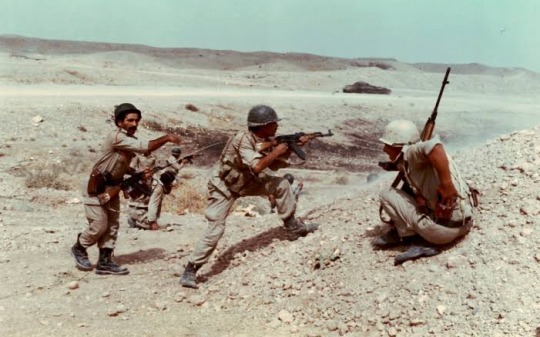
‘Mother of All Battles’
On the division’s way to its new position, they suffered an air attack followed immediately by an extensive armored assault in which 3 divisions from the American 7th Corps took part, with massive air support. The battle - known as ‘Battle of 73 Easting - was fought mainly between elements of the ‘Tawakalna’ Division and forces from the US 1st and 3rd Armored Divisions, the 1st Infantry Division and 2nd Armored Cavalry Regiment. American artillery and MLRS batteries played an important role in the battle.
The ‘Tawakalna’ Division fought an incredibly hard battle in difficult visibility conditions due to heavy dust that was stirred on the sandy terrain. Some of its formations were badly damaged but the division succeeded in reaching its rear positions, ending its participation in the war. Parallel to this, the Americans also attacked the lines of the ‘Nebuchadnezzar’ and ‘Adnan’ RG Divisions, even succeeding penetrating the Iraqi defensive lines on the morning of 27 February. As a result of the withdrawal and partial destruction of the ‘Tawakalna’ Division, Republican Guard Commander Gen. Iyad al-Rawi ordered the ‘Hammurabi’ RG Division to advance its 17th Armored Brigade to occupy new positions on the border between the sectors of the ‘Adnan’ and ‘Al-Medina’ Divisions.
The brigade moved to its new positions followed by 2 additional mechanized brigades and prepared for a counter attack. According to their version, the Iraqis sought a confrontation with the Americans advancing towards them from the West, and all of the Republican Guard’s artillery units bombarded American positions for over 3 hours. Next, the 17th Armored Brigade along with 21st Commando Brigade attacked in the sector of the ‘Adnan’ Division in Rumelia and managed to push back the forces that had occupied the defensive positions of one of its battalions. The ‘Adnan’ Division was later instructed to move in the direction of al-Qurna.
Another clash occurred between forces of the ‘Al-Medina’ Division and the American 7th Corps on the night of 26-27 February, after the latter attacked the Iraqi 14th Mechanized Brigade. The division mounted a counter attack with its 2nd Armored Brigade, reinforced by additional battalions, forcing the enemy to withdraw its forces to the rear. As a result, the American forces in the area increased their artillery fire in order to block the Republican Guard forces, who were attacking relentlessly and even making minor advances in some sectors.
The American 1st Infantry Division, which tried to advance across the sand dunes to flank the Iraqi line from behind, got stuck in this area, becoming a target for Iraqi artilllery and retreating helter-skelter from the area. At that point, forces from the ‘Hammurabi’ Division arrived in force in the sector between the ‘Adnan’ and ‘Al-Medina’ Divisions, deploying to mount a counter attack along with the ‘Al-Medina’ Division— a move that had the potential to threaten and encircle forces from the American 7th Corps in the Iraqi view.
While all this was taking place, forces of the US 18th Corps attacked the Special Forces Division of the Republican Guard in the Nasiriyah sector. An American force the size of a brigade (from the 101st) was also operating inside Iraqi territory in the Basra-Nasiriyah axis. The corps’ forces (82nd and 24th Divisions) mounted a frontal assault on the Iraqi positions from the south and west, attempting to gain control over them. Brutal fighting developed and continued throughout the day and into the night of 26-27 February, with the Iraqis, supported by heavy artillery fire, demonstrating very stubborn fighting spirit. In the end, the attack was stopped by the resistance of the Special Forces Division and by the heavy fog which covered the entire area.
Post-Battle Assessment

The Iraqis viewed these two battles - of the ‘Hammurabi’ and ‘Al-Medina’ Divisions and of the special forces in the Nasiriyah area - as a great victory for the Republican Guard, which had warded off a combined attack of two American corps on Basra and Southern Iraq. In their eyes, these developments, along with the 7th Corps’ failure to slice through the lines of the Republican Guard’s armored forces, had prevented the Coalition forces from taking control of Southern Iraq, destroying the mass of the retreating Iraqi military and/or disrupting their withdrawal back to Iraq. They portrayed the battles conducted by the Republican Guard as being among the greatest armored battles fought in modern history since WW2 in terms of the size of the formations and the number of armored vehicles taking part.
In their eyes, they had at least temporarily succeeded in effectively defending against and pushing back various American assaults, and even partially enveloping the American 1st Infantry Division, albeit very briefly. They concluded that the American High Command’s concerns about the 7th Corps taking further casualties and even being pushed back by the ‘Hammurabi’ and ‘Al-Medina’ Divisions caused them to agree to a ceasefire on the 28th of February and to put an end to the fighting. However, the Gulf War as a whole caused horrendous losses to Iraqi ground forces, who according to statistics from the USAF lost 2.500 tanks, 1.500 APCs, and 2.200 artillery pieces to enemy ground and air fire. However, later studies of Iraqi casualties during the war have shown them to have taken around 15.000 to 25.000 casualties, indicating that the RG had, in the end, succeeded in its task of sacrificing its own armored-mechanized brigades and divisions to allow the mass of the Iraqi army in the KTO (around 900.000 men) to retreat relatively unscathed back into Iraq. These forces, as well as the remnants of the RG, would prove pivotal in the Iraqi government’s response to the uprisings and mass-infiltration attempts of 1991.

Thanks for your attention! For further reading I would recommend Majid Khadduri’s “War in the Gulf”, the “Iraqi Perspectives Project” article covering the Gulf War, Pesach Malovany’s “Wars of Modern Babylon” and lastly the article “Correcting Myths about the Persian Gulf War: Last Stand of the Tawakalna Division”.
12 notes
·
View notes
Text
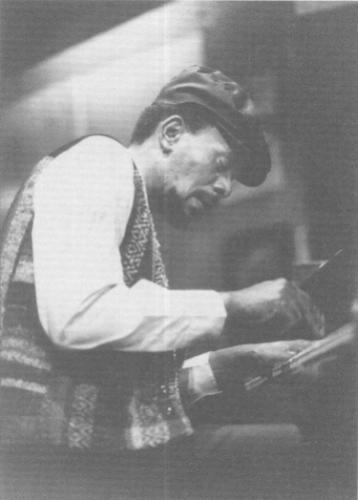
Horace Tapscott (April 6, 1934 - February 27, 1999) pianist, bandleader, and social activist committed his life to the empowerment of his South Central Los Angeles community. He founded the Pan Afrikan Peoples Arkestra and its umbrella organization, the Union of God’s Musicians and Artists Ascension, both of which were at the forefront of the vibrant community arts movement in Black Los Angeles.
He was born in Houston. His mother, Mary Malone Tapscott, was a professional singer and pianist. His family moved to Los Angeles in 1943. He spent his childhood learning piano and trombone, immersed in the richly diverse Central Avenue nightclub scene. After attending Jefferson High School and Los Angeles City College, he served in the Air Force, playing trombone in a service band. He found that the LAPD, operating had dismantled the Central Avenue arts scene. While on tour with the Lionel Hampton orchestra, he was hoping to reforge the communicative link between Black artists and the community.
He envisioned an orchestra that could preserve Black culture, perform original music, and foster community involvement. With local musicians, he formed the Underground Musicians Association, which established the Pan Afrikan Peoples Arkestra. The Arkestra engaged the youth through musical instruction, revised history courses, and remedial reading and math classes. The Arkestra performed in public schools, parks, community centers, churches, hospitals, and prisons.
Although the Arkestra played in support of diverse political groups, internally it stressed only the importance of self-expression. The Arkestra developed a key relationship with the Black Panther Party. He and Elaine Brown composed “The Meeting,” which became the Panthers’ anthem, and the Arkestra performed original musical arrangements to back Elaine Brown on her albums Seize the Time and Elaine Brown.
He continued to encourage any community member with an artistic spirit to perform in the Arkestra, embracing poets, dancers, and improvisational martial artists. #africanhistory365 #africanexcellence
2 notes
·
View notes
Text
FREE MUMIA NOW! BOOK LAUNCH & PANEL
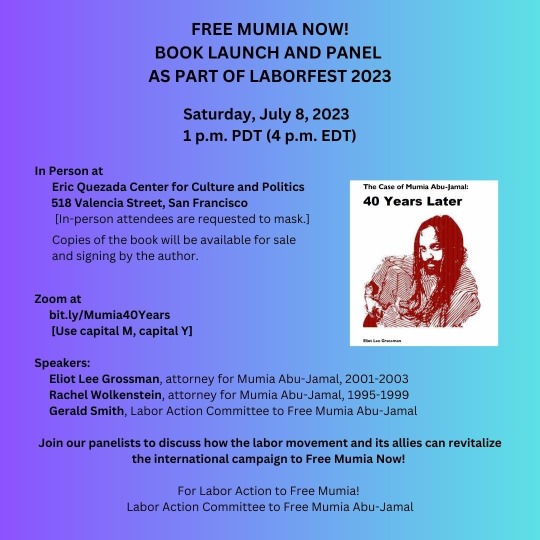
View On WordPress
#518 Valencia Street#African/Black experience#Afrikan#Black Panther Party#BPP#Eliot Lee Grossman#Eric Quezada Center for Culture & Politics#Free Mumia Abu Jamal#freedom#Gerald Smith#J. Michael Farrell#Jonathan Piper#LABOR ACTION COMMITTEE TO FREE MUMIA ABU-JAMAL#LAC#Marlene Kamish#Nick Brown#Partisan Defense Committee#protest#Rachel Wolkenstein Esq.#racial profiling#racism#revolutionary#The Case of Mumia Abu-Jamal: 40 Years Later#War on Afrikans
0 notes
Text
YURUGU'S AESTHETIC: THE POWER OF SYMBOLS
Sort of a continuation of my last review! In chapter 3 of Yurugu: An Afrikan-Centered Critique of European Cultural Thought & Behavior, it talks extensively about aesthetics and subsequently the Eurocentric concept of beauty.
Dr. Ani says, "First, we want to identify the European conception of beauty, in the sense of forms, images, experiences that evoke positive emotional responses from those who have been enculturated in the tradition. This sense of the European aesthetic is closely related to value; that is, its themes are “expressions” of European value. This is the aesthetic that reaches to every layer of the culture. The values and images involved are not limited to the ordinary person, although they are more consciously expressed in the media that addresses itself to the “nonintellectual”-- and to the popular art forms. But this should not confuse the issue, because (perhaps unconsciously or at least non-verbally) this aesthetic affects the “intellectual” as well.
We see examples of these value systems in the common protagonists of various films, TV and literature: usually white, usually a man, usually blond or blue-eyed (though not mutually exclusive). A cognitive conditioning and limiting of the viewer's imagination.
Dr. Ani continues: "In European culture, there is a second, other meaning of the term “aesthetic,” […] there is not only the experience of the beautiful, but there is the “objectification” of that experience as well. In keeping with the asili (logos) of the culture, it follows that there must be a “science” based on this objectification. […] This “scientific” or “philosophical” aesthetic seeks to influence and control the emotional experience of what Europeans consider "beautiful.” […] But none of these discussions is satisfying to anyone other than European philosophers. One questions their motives and the reason the subject occupies the attention and energy that it does. The answer is that this speculative/philosophic activity functions in its own way to reinforce and validate the cultural asili and to strengthen the national consciousness; the collective self-image as superior to others, a universal standard for humanity."
We notice this aesthetic pattern in Hollywood films like the Avengers (and other Marvel films), Top Gun, American Sniper, etc., in which the art forms have become a proverbial home to extensively propagandized logos and symbolism that specifically favor the U.S. military industrial complex, heteronormativity, and racism (anti-blackness, colorism, featurism, fatphobia etc.), while serving as a (currently failing) indoctrination technique for their military recruiters. Because of the objectification of these art forms, very few of the "average" viewers would question its value system or wish to abolish them.
Dr. Ani suggests that even writing, or the written word, "takes on the features of a dominant value within the belief system of the group. It is not merely a tool among tools. The medium of the written word is so valued that it can itself impart value (according to the European logos or asili), much as religion does to the entire fabric of traditional cultures."
I'd like to personally address the European aesthetics' ultimately appropriating nature, and what that mean for the Non-European viewer. In Dr. John Henrick Clarke's "On My Journey Now: The Narrative and Works of Dr. John Henrik Clarke, The Knowledge Revolutionary," he says about the West (USA specifically): "Practically all Black people in America are born into, grow up in, and must mentally, culturally and spiritually respond to the multi-dimensional perspective of the people who currently control the flow of information, values, and social ethics in this country. The educational institutions, through which Blacks receive their first formal instruction, are philosophically and pedagogically dominated by those same people, who also oversee the mass media, whether it is printed, electronic, focused on entertainment or part of the world wide web".
Dr. Clarke's longtime research on Afrikan history concluded that: "When Alexander came to Africa, instead of burning libraries (and that's one of the greatest myths of history, the burning of the Alexandria library), he sent the books home to Aristotle, who rewrote a lot of them and put his own name on them and so a lot of what you think is Aristotle's writings is plagiarism from African writings."
Dr. Ani has already spoken extensively of the Greco-Roman's obsession with ancient Kemet (Egypt) in her book, but I wanted to address this out of respect for the intention of her work, which does touch on the concept of an advanced Afrikan civilization and black nationalism in the essence of pan-africanism and the globalization of black solidarity. There are some aspects of European epistemology that she considers "brilliant" (her word exactly) in terms of its effectiveness. This book was meticulously written by an Afrikan woman for Afrikans and other Non-Europeans (she mentions Oceana and Amerindians more than once)(though she initially grew up in America, her Afrikan culture became her protection).
I think that the book is extremely thorough in its research and intentions, and so "enlightening" in the sense that I do think it's important to understand that there are other epistemological modes to consider that are not dominated by white supremacy. It was also a gateway to other great works that I can potentially read!
I started earnestly reading more black/Afrikan + Indigenous books and papers during the BLM movement way way back, because many black activists have stated that actually doing the work to understand racism and anti-blackness is the start to strong critical thinking skills against white supremacist propaganda. And they are correct.
But it also reveals how extremely insidious European epistemology and its allies can become. Their propaganda seems entrenched, ingrained, and still infiltrating. Nothing less than a strong cultural immune system would be able to fight it. I think Dr. Ani's work is an excellent start in comprehending this global problem, if you don't mind the complex wording of the texts. And if you do, I found Dr. Clarke's transcripts of his life's work available to read here!
#moony writes#yurugu#there's still a lot to learn ofc#and still critical thinking skills are necessary
2 notes
·
View notes
Text
We find Black Anarchism as a political tendency particularly attractive because of its flexibility—how it draws from a number of revolutionary frameworks—Black Marxism, Maoism, Pan Afrikanism, Black feminism, Queer liberation—which makes it not just opposed to the Western and capitalist forces oppressing Black people, but also the transmisic, heterosexist, misogynistic, disablist, and human-centered forces working against us as well.
Most of us in “anarchic” Black radical movements, however, find ourselves overlooked, and our politics get confused and dismissed as synonymous with classical, European Anarchism—which is itself often misunderstood by the non-anarchic world as largely an aesthetic and utopian movement, perhaps where people in bandannas smash windows or advocate an individualist liberty, a naive pacifism, or simply uncoordinated destruction and “chaos.”
It is within this milieu—of the increased popularity and relevance of anarchism to Black revolution, and the confusing or elusive nature of this relevance in the public consciousness due to anarchist mythology—that some of us decided we should develop our own name, to help demonstrate that we locate our anarchic radicalism in our own history as Afrikan/Black people.
#anarkata#black anarchism#anarchism#black liberation#lucy parsons#kuwasi balagoon#africa#afropessimism#racism#slavery#europe
66 notes
·
View notes
Text
11 notes
·
View notes
Text
Tupac Shakur and his activism
As I talked two weeks ago about the birth of rap in New York in the Bronx, today I want to talk about about a legend of rap music : Tupac Shakur.
Tupac was born in New York in 1971 but will move out during his teenage years to California, where he will begin his career of rapper in several groups before making himself famous by his own talent. He will sign a contract with Death Row Records and will lead a war against the famous East coast label Bad Boys Records. He will die at only the age of 26 of the result of this rivalry which was linked with gangs.
His political activism started in the womb : his mother was an active member of the Black Panther. By his mother’s values, by noticing scenes of police brutality (who often raided his home for information), and by the poverty he lived in, Tupac started to be engaged politically very early on. Before rapping, he associated himself to groups such as New Afrikan Panthers who worked against police brutality and abuse for example.
In the song Changes, written in 1992 but only released after his death in 1997, Tupac reflects on racism, police brutality, drugs and perpetuation of black poverty. https://genius.com/2pac-changes-lyrics
He also fought for feminism, a rare thing to see at this time in a rapper’s career. in his first album 2Pacalypse now, he wrote and interpreted "Brandy's Got A Baby" In this song, he denounces the rejection from families and friends but also the fact of being a young mother in a poor neighbourhood where the government show a considerable lack of financial support. This song is inspired from a true story that Tupac read on the newspaper.
Tupac’s feminism doesn’t stop here, he also wrote a song on her mom "Dear Mama" which retrace her mother and Tupac’s life story. Again in this song, he talks about his mom and her strength in rising two kids alone, their fight in poverty, his drugs dealing to survive… This song is not just about his mom but for all mother who are fighting to raise kids alone.
His legacy on political and cultural activism continue through association : Tupac Amaru Shakur Center for the Arts and the Tupac Amaru Shakur Foundation, both to help those in difficulty to access health care or cultural things.
My article is of course related to the chapter Politics.

9 notes
·
View notes